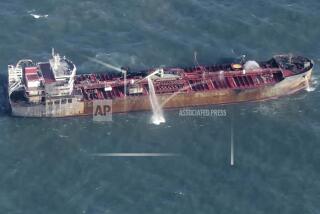Whatever Happened to Tanker Reform? : Huge Shetlands spill recalls the infamous 1989 Exxon Valdez disaster
- Share via
The catastrophe unfolding on the Shetland Islands off northern Scotland revives painful memories of the 1989 Exxon Valdez spill, which choked miles of Alaska’s pristine coastline with gobs of environmentally devastating oil. The tanker Braer, which ran aground near the rocky shore of Quendale Bay Tuesday, was carrying 25 million gallons of oil--more than twice the cargo of the Exxon Valdez.
Once again, adoption of adequate safety measures and emergency-response plans will come too late to save one of the world’s premier wildlife habitats. Britain is only now considering tightening restrictions on single-hull tankers operating in environmentally sensitive areas.
Meanwhile, despite the lingering environmental damage to Alaska’s Prince William Sound, the billions spent in cleanup costs there and the passage of new federal laws designed to reduce the likelihood of oil spills, the potential for more accidents in U.S. waters remains frighteningly and needlessly high.
Though oil spills since 1989 had not approached the scale of the Alaska disaster, accidents last year at ports in Boston, New Orleans, New York, Philadelphia and Seattle each resulted in the spilling of more than 300,000 gallons.
When Congress passed the Oil Protection Act in 1990 after the Exxon Valdez incident, the law was intended to impose tough new government standards. They included interim safety measures for single-hull ships as safer double-hull tankers are phased in by 2015, tugboat escort requirements for ships operating in environmentally sensitive areas, harbor-wide emergency response plans, and extending federal safety standards to foreign vessels that operate in U.S. waters.
But according to a report recently issued by the Natural Resources Defense Council, there are troubling indications that large parts of the Oil Protection Act have not been implemented. Among these are provisions requiring “substantial protection” for single-hull vessels--like the Braer--which make up 95% of all tanker traffic in U.S. waters. Moreover, despite the formation of spill response plans, crews and local authorities lack the equipment needed to contain and clean up oil spills in a worst-case scenario.
In just four years, 89% of the world’s tanker fleet will be 15 or more years old. With demands for oil imports expected to increase, that means more risk.
The heartbreaking scenes of oil sullying the once beautiful shores of the Shetland Islands underscore the need to commit to making navigable waters safe from that kind of environmental degradation. There are some things no amount of insurance can pay for.
More to Read
Sign up for Essential California
The most important California stories and recommendations in your inbox every morning.
You may occasionally receive promotional content from the Los Angeles Times.









